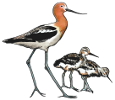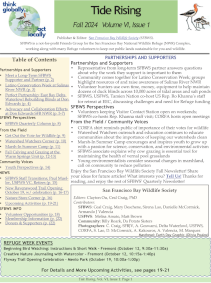San Francisco Bay Wildlife Society negatively impacted by partial US government shutdown since December 22, 2018
by Ceal Craig
As I write this our Refuge Complex, the Don Edwards San Francisco Bay National Wildlife Refuge, has been shutdown for almost three weeks. What does that really mean? The Refuges are “open,” aren’t they? To public visitation on the trails, yes. But other outcomes are happening:
- On Saturday, January 12th, three different programs were scheduled that would have reached 60-70 people, including a group of 20 local high school students; those had to be cancelled. These programs are essential to our local community and connect new and diverse audiences with their local natural resources.
- Restoration work is extremely important to keeping our habitats sustainable for native wildlife and has not been done since the shutdown began.
- Invasive plant species are mostly likely starting to sprout at this time, growing quickly and overtaking critical native species since they cannot be pulled by volunteers.
- Nature Store sales are conducted Tuesday – Saturday, providing visitors with educational items and profits that directly benefit the Refuge Complex.
- The Environmental Education program for the Refuge Complex has also been affected. Many field trip programs at Don Edwards SFBNWR have been cancelled.
- Practically all USFWS staff have been on furlough.
This situation is negatively impacting our Refuges, the programs we deliver, and commitments we’ve made to the public our grantors and donors.
(NOTE: SFBWS employees are not USFWS employees and thus are not subject to the shutdown but have to work from home or use rented office space since USFWS provides office space for us and is the location of most of our programs).
With some trepidation because of the shutdown, the first week in January, my niece and I made our annual birding trip, this year to the San Luis NWR Complex Refuges. While we still saw thousands of snow and greater white-front geese, many sandhill cranes, and numerous ducks and shorebirds on the autoroutes and trails, we brought our own toilet paper, cleaning materials, and had no current road status to tell us what was happening inside the San Joaquin River, San Luis West Bear Creek Unit, and Merced Refuges we visited.
While most visitors were respectful of rules for using these Refuges, we saw people outside their cars on the autoroutes (not allowed normally) probably negatively affecting the wildlife that live in those habitats. The San Luis NWR Visitor’s Center was closed; a lost education opportunity for my high-school age niece.
As of January 10, using leftover funds from the prior fiscal year, the FWS is now planning to staff more fully (for about a month) 38 Refuges throughout the nation including from our Region: Sacramento, Delevan, Colusa, Sutter, San Luis, Merced, Kern, and Pixley. All in the Central Valley, critical resources supporting thousands of migrating waterfowl. Sounds good, right? But we see this as a very mixed message: are some Refuges more important than others? Is it fair that some employees are paid while others work alongside them (e.g., Law Enforcement) were not paid? Will this become the norm where Refuges are opened for some purposes but not others? Is our urban Refuge Complex not worthwhile compared to others? This partial solution does not solve the overall problem of keeping the nationwide Refuge system healthy, serving their purposes, and be available.
How this situation ends is currently unknown to us. Whatever your politics, it is frustrating, unacceptable, and costly. I encourage you to write your congressional representatives and share your feelings about this situation. Speaking for the San Francisco Bay Wildlife Society staff and volunteers, we want to deliver education programs, do invasive weed control, work hand-in-hand with our Refuge partners, and support the public effectively in their visits to our Refuges.
Respectfully,
Ceal
Cecilia (Ceal) D. Craig, PhD
President, SFBWS Board of Directors
Ceal.Craig@SFBWS.com
Update: The United States federal government partial shutdown that began on Saturday, December 22, 2018 ended on Friday, January 25, 2019.
The federal shutdown resulted in a loss of:
- Education & Interpretation Programs: Over 400 students and members of the public were not able to participate in scheduled programming. Refuge staff were unable to reschedule most of these programs due to limited availability in future weeks.
- Hundreds of Volunteer Hours: Volunteers were not able to work on Refuges restoring habitat, connecting visitors to the resource, educating students, and assisting biologists.
- Natural Resources: San Francisco Bay is critical habitat for many migratory and endangered species. Refuge staff manage this habitat, ensuring optimal conditions for wildlife and plants. Critical surveys, sampling, and restoration work were not done or postponed, affecting results.
Community Highlights
- Trash: Community members were seen picking up trash along trails, in parking lots, and along roadways in and around Refuges.
- Improvising Needs: Dog walkers placed their doggy bags in a box near the main trailhead at Don Edwards NWR in Fremont since trash receptacles could not be emptied.
- Friends Group Support: San Francisco Bay Wildlife Society (SFBWS) was able to deliver one public weekend program at another site, and was able to continue communication with teachers, volunteers, and program participants. The SFBWS Facebook page also provided updates to the public.
How You Can Get Involved
Become a volunteer, join our free public programs on Saturdays, join SFBWS by signing up to be a member, and spread the word about your local National Wildlife Refuges! Email Hope at hope.presley@sfbws.com to learn more!


